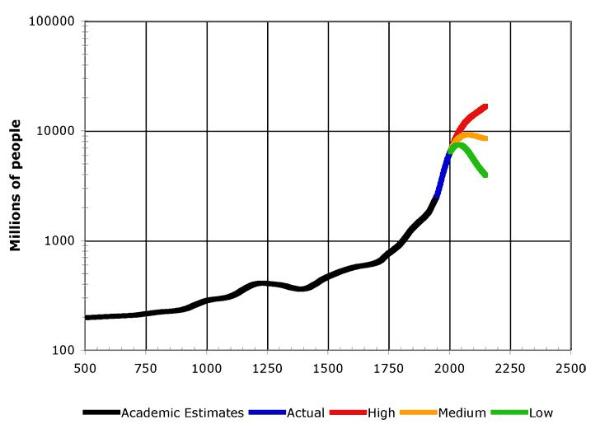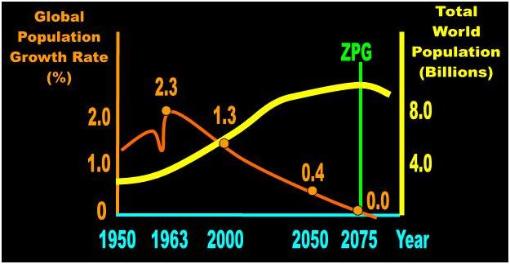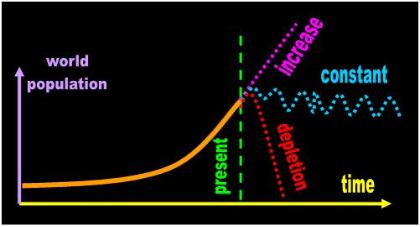| Adapted for the Internet from: Why God Doesn't Exist |
| The three population curves |
1.0 The Curve of Life: There are three possible population curves
It is no secret to most people nowadays that the population of humans has expanded exponentially in the last 200 years.
What is less well known is that, although the population of the world is still growing, it is doing so at a slower rate than in
the past. 1963 was the glorious year in which we turned the corner. [1] The slope of the population curve went from
convex to concave. Since then, the global rate of growth of humans has been steadily decreasing. I emphasize that I am
referring to global population. I clarify this because most people have in the back of their minds that Africans breed like
rabbits and will make up the shortages in no time. Not only is this untrue, but it has no bearing on what I just said. The
global birth rate is what is decreasing and that includes Africans. If this rate drops to zero, we attain what is known as
zero population growth (ZPG). For every person that is born somewhere, another one dies, and at the end of the year
there is no net gain.
Since 1990, U.N. demographers have consistently revised the date of ZPG downwards. [2] Two decades ago they predicted
that our species would attain ZPG in the 22nd Century. The current revision predicts that it will happen in 2075. [3] Therefore,
the experts seem to agree that we will attain ZPG within this century.
These trends should alert you to the fact that we live in special times. The raw numbers presage that at some point the global
population will begin to decline. We have never had this happen to us in our history.
The demographer and the historian will protest. We had a population crash in the 14th Century, and we didn’t recover our
numbers until a couple of centuries later.
They are correct. There was a global crash, specifically in the population of Europe and due to the Black Death
(1347 - 1352). [4] But here, I am not talking about a crash. I am talking about a sustained decline in the rate. This is a new
phenomenon:
" population growth is slowing down at this moment. However, that slowdown itself
is a revolutionary event, which breaks a trend that has persisted over all of human
history." [5]
The discussion is not about an unexpected accident, a spike in an otherwise smooth trend. This time we can predict and
guarantee that, whether sooner or later, the total population of the world will at some point reach a plateau, the maximum
number of inhabitants we had at any one time (Fig. 1).
- ________________________________________________________________________________________
- Last modified 03/03/08
- Copyright © by Nila Gaede 2008

Since 1963, the rate of growth of global population has been steadily declining. Current projections sug-gest that the rate
will drop to zero by 2075. The global population will have then reached a zenith (of about 9.2 billion) and then is expected
to drop a tad until it settles at a new plateau. This sustained decline is a new phenomenon in the demographic history of
Man. We have had spikes in the curve before, but not smooth, prolonged, predictable negative slopes.
Maybe not all demographers will agree with the historical trends I just proposed, but not one will challenge that the birth
and fertility rates are steadily coming down. A sustained decline leads to ZPG.
Once we attain ZPG, we can expect only one of three trends (Fig. 2). The population could:
• rebound and begin exponential growth again (more people are born than die)
• stabilize around an optimal level (births approximately equal to deaths)
• continue to decline until we reach extinction (more people die than are born)
Fig. 1 Recent and predicted population growth rate and total population trends |
I repeat so that we don't miss the point: after we reach ZPG some time around the year 2075, there are only three possibilities.
The population continues to increase, remains essentially constant, (oscillating up and down for the rest of eternity), or falls
to zero (extinction). Which of these three trends will we follow? Will the Africans studs come to the rescue and multiply their
seed biblically: like the sands of the desert? Will population recover to its former glory and continue oscillating up and down
for the next billion years like some UN demographers predict? Or will our numbers continue to decline until there is no one
left?
In order to estimate what numbers the future may bring, it is helpful to review the population trends we had in the past. The
strategy I have in mind is simple. If we can discover the factors that caused the population curve to deflect in the past, we
can perhaps use them to speculate intelligently about future trends.
Fig. 2 The Curve of Life The three possible demographic curves |


- Module main page: The mechanism behind background extinctions
Pages in this module:
- 1. This page: The three population curves
2. All species eventually conquer the invisible bugs that keep their numbers back
3. Not education, but urbanization causes infertility
4. Urban women have no freedom to choose whether to have a baby
5. An urban woman doesn't have the privilege or need to have a family
6. Density is what overturns a pyramid
7. Urbanization was inevitable
